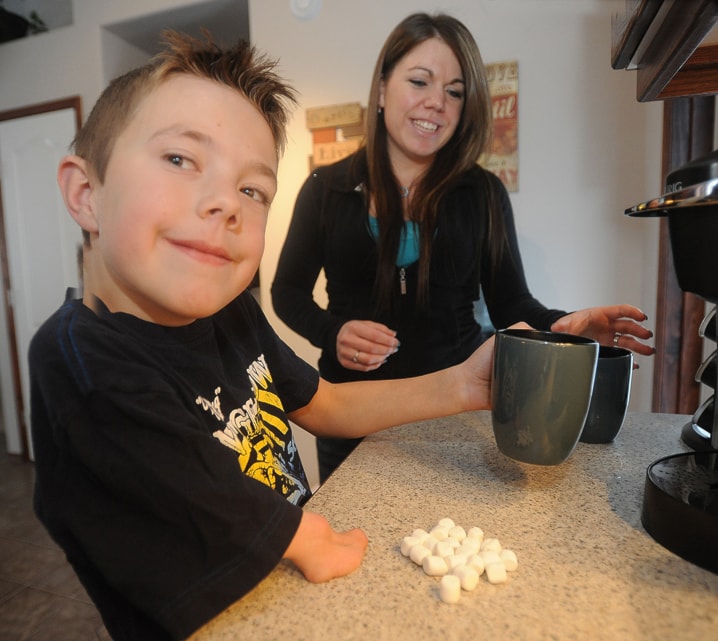He’s the tallest child in his Grade 2 classroom, runs like the wind and has set his sights on becoming a soccer coach and designing electronic games.
Sitting on the living room floor of his family’s Red Deer home, seven-year-old Bryce Bainbridge uses the big toe on his left foot to brace the base of his Lego board while manipulating tiny pieces in his left hand, his under-developed right arm providing support as needed.
“I was born this way,” Bainbridge tells people who are curious about the thin little arm that ends about where his elbow should be.
While the tiny arm may affect a few things, it doesn’t prevent Bainbridge from doing the things he loves. He was playing Nintendo at a year and a half and had it mastered by the time he was two, says his mom, Rachelle Buehler.
He can build a Lego robot or a Lego dog in 20 minutes.
Today’s creation is a tiny humanoid, maybe three centimetres tall with a tiny jetpack and a Sponge Bob head.
“It’s half zombie and half Sponge Bob and half human,” says Bainbridge, happily oblivious to the mathematical improbability of his description.
As Bryce has done with his arm, 25-year-old Kyra Herzog, raised in Red Deer and now studying Education at the University of Alberta, learned to adapt to being born with a little bit of toe where her right leg should have been. The tiny toe was amputated while she was still a baby.
Diagnosed with VATER Syndrome, Herzog also has a spinal deformity and is missing a kidney. It’s typical for people with VATER to have three different parts of their body affected, she said. The acronym stands for vertebrae, anus, trachea, esophagus, and renal (kidney), the parts most commonly affect.
Herzog wore an artificial leg for awhile, but switched to using crutches when her prosthologist died suddenly from a sleep disorder. She was too upset to go to another specialist and found that, with crutches, she had no problem keeping up with her friends and, with a few adjustments, does all the things everyone else does.
A huge factor in helping Bainbridge and Herzog learn to deal with their malformities has been CHAMP, the Child Amputee program of War Amps of Canada, founded in 1918 to serve soldiers injured in the First World War.
This year, War Amps celebrates the 30th anniversary of CHAMP, set up to help child amputees and their families, including offering financial assistance toward the purchase of artificial limbs along with seminars to help children learn to manage the implications of missing a limb.
Those implications include bullying by other children and the tendency for people to stare, says Herzog, who gives talks about the program.
“They do stare. When it’s kids, I just kind of walk up to them and I’ll explain. Most will ask what happened and parents (try to hush them).”
Seminars with CHAMP helped with the social aspects of having a missing or artificial limb, said Herzog. She believes that, outside an incident of verbal abuse from another girl during middle school, people haven’t picked on her because she is strong-willed and not afraid to tell them where to go.
“(CHAMP) really encouraged me. They showed me that having this disability wasn’t actually a disability. I bike ride, I rollerblade, I ski,” said Herzog.
“I look at it like, you grew up and you learned how to do this with two legs and I grew up and I had to do it with one. It might have taken be a little bit longer, but I still figure it out, right?”
Financially, the CHAMP program has enabled her to purchase a new prosthesis, which she has decided she needs because her body is breaking down from the stress of using crutches.
Herzog’s new leg, purchased in British Columbia, cost about $14,000 in total with Aids to Daily Living, an Alberta Health Services program, covered only about $8,000. CHAMP picked up the balance.
Bainbridge was given a prosthetic arm when he was smaller, but soon outgrew it and decided not to get another for awhile. He is getting a new arm soon, however, so he can do things like play on the monkey bars.
He and his family are paying back by offering the War Amps whatever they can in time and donations.
This year, Bainbridge gave $675 to the CHAMP program, including all the money the tooth fairy brought him for the eight teeth he has lost. Buehler said he actually pulled one out without waiting for it to come loose on its own.
Herzog said she likes the War Amps message: Play safe, drive safe.
“I know from their message what to watch for. But for someone who doesn’t it’s just innocent fun for them until they get hurt.”
bkossowan@www.reddeeradvocate.com
— copyright Red Deer Advocate
